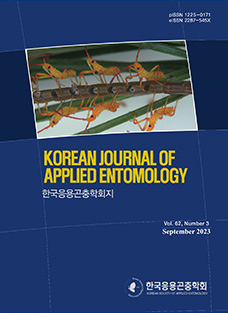The subfamily Calaphidinae Oestlund, 1919 represents the second most diverse group in the family Aphididae Latreille, 1802 (Hemiptera: Aphidoidea), comprising approximately 480 species with worldwide distributed (Favret, 2025). The majority of diversity within this group in concentrated in the Holarctic region (Blackman and Eastop, 2025). Members of Calaphidinae exhibit a broad host range, feeding on approximately 20 different families (Blackman and Eastop, 2025). These aphids predominantly inhabit woody plants, with the most common hosts families including members of the Fagaceae, Betulaceae, and Ulmaceae. However, several genera including Chucallis Tao, 1963, Saltusaphis Theobald, 1915, and Thripsaphis Gillette, 1917 have adapted to feed on Poaceae plants, particularly bamboos and sedges. Within the Korean peninsula, Takecallis Matsumura, 1917 remains the only documented calaphidine group associated with bamboo hosts.
The genus PhyllaphoidesTakahashi, 1921 was originally described from Taiwan and has subsequently been recorded in mainland China (Blackman and Eastop, 2025) and Japan (Yoshitomi and Hayashi, 2022). Currently, it is recognized as a monotypic genus, with Phyllaphoides bambusicola as its sole known species (Favret, 2025). This species colonizes the undersides of bamboo leaves, with documented hosts including Bambusa stenostachya (Poaceae) (Takahashi, 1923) and various Phyllostachys species (Poaceae) (Blackman and Eastop, 2025). The lifecycle of P. bambusicola remains not yet fully understood, with variation in reproductive strategies observed across its range. In mainland China, oviparae have been documented in December, suggesting a sexual reproductive phase. Convertsely, populations in Taiwan maintain parthenogenetic reproduction throughout winter seasons. This reproductive flexibility likely reflects the tendency of certain aphid species to bypass sexual reproduction in warmer climates (Dixon, 1985). Japanese populations have yielded both alate and apterous morphs, through formal description of the apterous form have yet to be published (Takahashi, 1923).
Recent investigations into the Japanese distribution of P. bambusicola have revealed its range expanding throughout the country (Yoshitomi and Hayashi, 2022). First detection a an invasive in Kyushu (Fukuoka Prefecture) in 2019, P. bambusicola has continuously expanded its distribution across Japan (Yoshitomi and Hayashi, 2022). In these newly colonized areas, the species has become an important bamboo pest, promoting sooty mold development on bamboo foliage through honeydew excretion (Fig. 1). This infestation not only compromises the aesthetic value of bamboo plantings but may also negatively impact plant vigor and growth rates.
The recent discovery of P. bambusicola in South Korea marks its first recorded occurrence in the country. This study employs COI (cytochrome c oxidase subunit I) sequencing, a widely utilized molecular approach for species identification. We provide comprehensive morphological documentation including photographs, description, morphometric data, and microscopic images of slide-mounted specimens of this newly recorded species.
Materials and Methods
Aphid samples were collected in South Korea from 2023 to 2024. All samples were preserved in 90–95% ethanol for over one month before being mounted in Canada balsam, following the methods described by Blackman and Eastop (2000) and Martin (1983). Illustrations for each species were captured using a digital camera attached to the microscope (Leica DM 2500, Leica Microsystems, Germany) at a resolution of 600 dpi. Measurements for each specimen were taken from these digital images using image analysis softwares, Mosaic V2.3 (Tucsen Software) and HeliconFocus 7 (Helicon Soft). All specimens are deposited at Kunsan National University, Republic of Korea (KSNU).
Aphid samples were identified using original species description by Takahashi (1921) and Quednau (2003). Abbreviations used in the diagnosis, description, figures, and Table 1 are as follows: BL, Body length; ANT, antennae; ANT I–VI, antennal segments I–VI; BASE, basal part of last antennal segment; PT, processus terminalis of last antennal segment; Ls ANT III, longest setae on ANT III; BD III, basal diameter of ANT III; URS, ultimate rostral segment; Co, costa; Cu, cubitus; M, media; Pts, pterostigma; Rs, radial sector; FEM, hind femur; TIB, hind tibiae; HT 2, second segment of hind tarsus; SIPH, siphunculus; ABD TERG I–VIII, abdominal tergites I –VIII. Table 1 presents the main morphological characteristics of P. bambusicola, including measurements (in mm), number of setae on antennal segments, number of rhinaria, and body part ratios.
In this study, three sequences were obtained from specimens of P. bambusicola collected in South Korea (accession numbers: PQ779081–PQ779083) and compared them with 17 sequences downloaded from GenBank, resulting in a total dataset of 20 sequences. The sequences were aligned using MEGA 7 (Kumar et al., 2016). Intra- and inter-specific distances were calculated using the pairwise distance method based on the Kimura- 2-Parameter (K2P) model (Kimura, 1980). Additionally, a neighbor-joining (NJ) tree was established based on the K2P model using the final dataset of 560 bp.
Taxonomy
Genus PhyllaphoidesTakahashi, 1921 (Korean name: 솜털 대알락진딧물속)
PhyllaphoidesTakahashi, 1921: 75–76.
Type-species.Phyllaphoides bambusicolaTakahashi, 1921
Generic diagnosis. Similar to Subtakecallis Raychaudhuri & Pal, 1974, but lacking the nose-like process on the clypeus. Eyes without ocular tubercle. Dorsal tubercles are undeveloped, marginal tubercles are small and inconspicuous. Ratio PT/ BASE = 0.70–0.85. Empodial setae are missing. Wax gland pores are highly developed on all femora.
Phyllaphoides bambusicolaTakahashi, 1921 (Korean name: 솜털대알락진딧물)
Material examined. 10 alate viviparous females, 558, Daehak- ro, Gunsan-si, Jeonbuk-do, Republic of Korea, 35°56'35"N, 126°40'50"E, on Phyllostachys bambusoides, S. Kim leg., 12.x.2023, no. 231012SJ-2; 10 alate viviparous females, ditto, on P. bambusoides, Y. Lee leg., 07.vii.2024, no. 240707YR-2.
Description.Alate viviparous female: Color in life (Fig. 2). Head pale yellow, compound eye red. ANT pale, marginal borders of ANT III–V and ANT VI dusky. Thorax and ABD TERG pale to pale yellow. Legs pale, tip of tarsi slightly dusk. Wing veins pale, not conspicuous. SIPH pale. Cauda pale. Entire body covered with white wax.
Morphology (Fig. 3). Body oval, BL 1.45–1.82 mm long. Head with three pairs of anterior and two pairs of posterior short and pointed hairs about 0.01 mm long, median protrusion on frons developed, epicranial suture developed, antennal tubercles slightly developed, dorsal tubercles on head missing. ANT 6-segmented, 1.43–1.63 mm long, ANT 0.81–0.90 × BL, ANT III longest with 3–5 oval secondary rhinaria in one row on the basal 1/3 of the segment, the last rhinarium attached slightly apart from the others, Ls ANT III 0.33–0.50 × BD III, distal 1/3 of ANT III-VI imbricated, ANT IV without secondary rhinaria, ANT IV slightly longer than ANT V, PT 0.63– 0.76 × BASE. Clypeus without processus. Rostrum short, extends slightly beyond fore coxae, URS short blunted, 0.05 mm with six accessory setae, URS 0.29–0.33 × BASE, 0.31– 0.33 × HT 2. Thorax smooth without tubercles. Fore coxa enlarged. Longest setae on TIB 0.40–0.75 × middle width of TIB, first tarsal segment with 4–5 setae, HT 2 0.13–0.16 mm long. Wing vein clear, without dark spots. Dorsal ABD TERG I_VIII with one pair of spinal setae, dorsal tubercles missing, marginal tubercles developed, each marginal tubercle bears one single seta. SIPH very short 0.02 mm long, pore-like in shape, bearing 0.01–0.02 mm of one single seta. Cauda knobbed 0.10–0.13 mm long with 6–10 setae. Anal plate bilobed with 12–17 setae.
Distribution. This species is originally described from Taiwan, later discovered in mainland China, and subsequently found in Japan in 2019 and in South Korea for the first time in 2023. Taiwan (origin, Takahashi, 1921), China (Tao, 1964), Japan (Yoshitomi and Hayashi, 2022), South Korea (Gunsan, present study).
Host plant. Previous studies have reported this species on the undersides of leaves of Bambusa stenostachya (Poaceae) (Takahashi, 1923) and Phyllostachys spp. (Poaceae) (Liao, 1976). In Korea, this species was discovered densely clustered on the undersides of Phyllostachys bambusoides (Poaceae) leaves.
Remarks. While the original description states that the eyes are black (Takahashi, 1921), they are actually red. It was also reported that when threatened, it quickly walks away to escape; however, we observed it jumping.
Molecular Analyses and Discussion
The Neighbor-Joining (NJ) tree based on COI sequences demonstrates that P. bambusicola specimens collected in South Korea align with the reference sequences available in GenBank (Fig. 4). Intraspecific genetic variation within P. bambusicola, as determined by COI analysis, was observed to have a mean of 0.17%, with a range from 0% to 0.73%. Intraspecific variation in Calaphidinae generally ranges from 0– 0.7% (Lee et al., 2017). These molecular findings, combined with detailed morphological examination, provide strong evidence for the identification of P. bambusicola in South Korea, representing the first documented occurrence of this species in the country.
The cultural significance of bamboo in East Asia is so profound that the civilizations of Korea, China, and Japan are often collectively referred to as "bamboo civilizations" (Yun, 2014). Bamboo's significance in East Asia transcends landscaping, occupying a unique cultural role unrivaled by any other plant species. In East Asia, since ancient times, bamboo has been used as a material for various crafts and buildings, and even as a food material, so it is recognized as a very important natural resource and has been widely cultivated. The recent discovery of P. bambusicola in South Korea is of considerable importance, especially given its status as a significant pest in Japan. It suggests a direct threat to bamboo cultivation. During the collection of this species, we observed a severe infestation, with the undersides of bamboo leaves entirely covered in white wax, indicative of a significant outbreak. The proliferation of the species may negatively affect the ornamental quality of bamboo, which is critical to its use in landscape architecture, thereby reducing its horticultural significance.
It is hypothesized that P. bambusicola was introduced to Korea either through trade with China (including Taiwan) and Japan or via natural dispersal mechanisms, such as wind currents, similar to the well-documented long-distance migrations of the brown planthopper (Nilaparvata lugens) and the whitebacked planthopper (Sogatella furcifera) across East Asia. This introduction highlights the need for enhanced quarantine cooperation among East Asian countries. The discovery of this pest highlights the need for stronger quarantine measures and regional cooperation to control invasive species, especially considering that natural dispersal pathways through atmospheric circulation are difficult to regulate but can be monitored through regional surveillance networks.













 KSAE
KSAE





